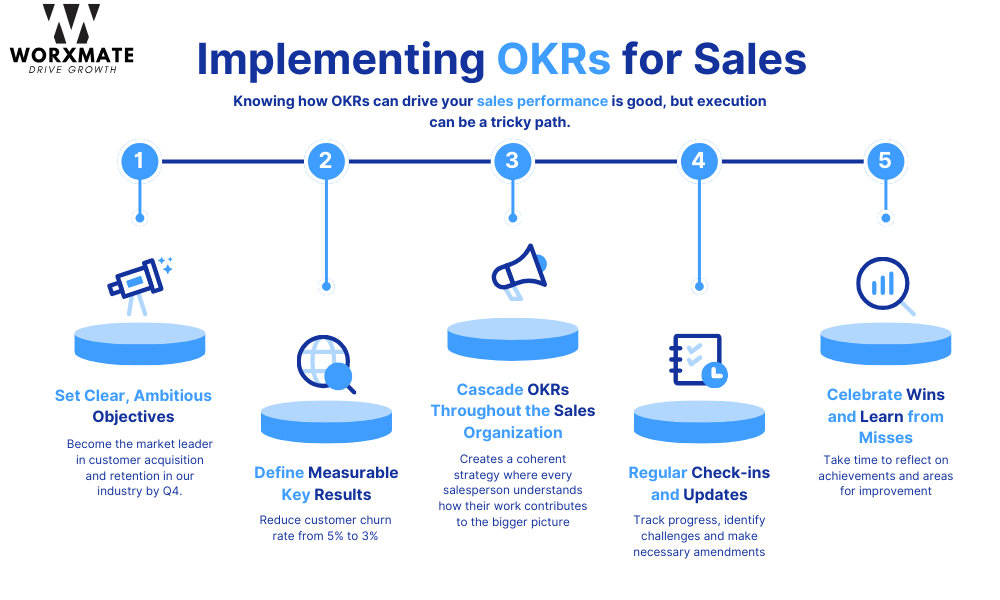“Drive growth with AI-driven performance management solutions. Register now for exciting offers.”
- Product
Product Overview
Deep AI
Define, execute, evaluate and plan your OKR journey
OKR Solution
Discover focus, alignment and celebrate success
Task Management
Prioritize, plan, and deliver tasks effectively
Performance Management System
Manage, Evaluate, and Increase Employee Performance
Join leading organizations relying on Worxmate for efficient OKR management and success
Persona
CHRO
Optimize HR functions with our AI-driven performance management
CEO
Explore strategic leadership insights and best practices for CEOs
Strategy Head
Drive strategic excellence with insights and alignment that fuel innovation and organizational success.
Product Head / CPO
Empower your product leadership with strategic insights and goal alignment to drive innovation and success
Join leading organizations relying on Worxmate for efficient OKR management and success
Product Overview
Deep AI
Define, execute, evaluate and plan your OKR journey
OKR Solution
Discover focus, alignment and celebrate success
Task Management
Prioritize, plan, and deliver tasks effectively
Performance Management System
Manage, Evaluate, and Increase Employee Performance
Join leading organizations relying on Worxmate for efficient OKR management and success
Persona
CHRO
Optimize HR functions with our AI-driven performance management
CEO
Explore strategic leadership insights and best practices for CEOs
Strategy Head
Drive strategic excellence with insights and alignment that fuel innovation and organizational success.
Product Head / CPO
Empower your product leadership with strategic insights and goal alignment to drive innovation and success
Join leading organizations relying on Worxmate for efficient OKR management and success
- OKR Consulting
- Pricing
- About Us
- Contact Us
- Resources
- Articles
Boosting Sales Performance with Business OKRs: A Practical Guide for Sales Heads
- September 3, 2024
- 5 min read

It’s the end of another quarter, and you’re staring at a sales report that falls short of expectations. Your team worked tirelessly, but somehow, the numbers don’t reflect their efforts. Sound familiar? You’re not alone.
In boardrooms across the globe, sales heads are grappling with a paradox: despite advanced CRM systems, AI-powered analytics, and cutting-edge sales tools – achieving a desired sales targets remains elusive. But what if the key to unlocking your team’s full potential isn’t about working harder, but working smarter?
That’s where Objectives and Key Results (OKRs) step in. OKRs for sales performance is a game-changing approach that’s revolutionizing how top-performing sales teams operate and succeed. And we don’t have to look far for proof of its effectiveness.
Zynga, the social gaming giant, shows us how.
Zynga faced a critical challenge: declining user engagement and lagging sales. With competition intensifying and a pressing need to innovate, Zynga found itself at a crossroads. To address these challenges, Zynga turned to OKR framework.
According to “Radical Focus” by Christina Wodtke, Zynga implemented OKRs to realign its sales strategies with clear, actionable objectives that revitalized user engagement and boosted sales performance. As a result, the company not only reversed its declining sales but also positioned itself for sustainable growth in a competitive market.
This success story begs the question: What if your sales organization could replicate Zynga’s success? Imagine transforming your own challenges into opportunities, realigning your sales efforts, and achieving remarkable growth.
The good news is, you can achieve similar results by understanding the intricacies of the OKR framework and implementing it effectively within your sales team.
The Sales Conundrum: Challenges in the Modern Sales Ecosystem
Before we dive into the solution, let’s address the complex challenges that today’s sales organizations face:
Pipeline Velocity Stagnation:
Despite robust lead generation efforts, many sales teams struggle with moving prospects efficiently through the sales funnel. This results in extended sales cycles and decreased win rates.
Misalignment between Marketing Qualified Leads (MQLs) and Sales Qualified Leads (SQLs):
The disconnect between marketing and sales often leads to a high volume of low-quality leads, wasting valuable sales resources and creating friction between departments.
Ineffective Account-Based Selling (ABS) Strategies:
Many organizations struggle to implement and measure the success of their ABS initiatives, leading to missed opportunities with high-value accounts.
Challenges in Sales Forecasting Accuracy:
Inaccurate sales forecasts due to subjective pipeline assessments and lack of data-driven insights lead to resource misallocation and missed revenue targets.
Inefficient Territory and Quota Management:
Imbalanced territory distribution and unrealistic quota setting often result in underperforming sales reps and oversaturated markets.
Difficulty in Measuring and Improving Sales Productivity Metrics:
Many organizations struggle to define and track meaningful sales productivity KPIs, such as sales activity ratios, conversion rates at each stage of the sales process, and time spent on selling activities versus administrative tasks.
How OKRs Address These Sales Challenges?
OKRs provide a powerful framework to tackle these complex sales challenges head-on:
Accelerating Pipeline Velocity:
OKRs can focus the team on specific actions to speed up the sales cycle. For example, an objective to “Optimize the sales funnel for faster conversions” could have key results like “Reduce average time from MQL to SQL by 20%” or “Increase opportunity-to-close ratio by 15%.”
Aligning Marketing and Sales:
OKRs can bridge the gap between marketing and sales by setting shared objectives. A joint objective like “Improve lead quality and conversion rates” could have key results such as “Increase SQL to opportunity conversion rate from 20% to 30%” and “Reduce lead disqualification rate by 25%.”
Enhancing Account-Based Selling:
OKRs can drive and measure ABS initiatives effectively. An objective to “Maximize impact of Account-Based Selling program” might include key results like “Increase average deal size for target accounts by 30%” or “Achieve 50% faster sales cycle for ABS accounts compared to non-ABS accounts.”
Improving Sales Forecasting:
OKRs can enhance forecasting accuracy by focusing on data-driven predictions. An objective to “Achieve best-in-class sales forecasting accuracy” might include key results like “Reduce variance between forecasted and actual sales to less than 5%” or “Increase win rate of ‘commit’ stage opportunities to 85%.”
Enhancing Territory and Quota Management:
OKRs can drive more effective territory and quota strategies. An objective to “Optimize territory and quota allocation” could have key results such as “Reduce territory performance variance to less than 10%” or “Increase the percentage of reps achieving quota from 60% to 80%.”
Boosting Sales Productivity:
OKRs can focus efforts on improving key productivity metrics. An objective to “Maximize sales team productivity” might include key results like “Increase average revenue per sales rep by 25%” or “Reduce non-selling activities by 30% through process automation.”
By implementing OKRs, sales organizations can address these challenges systematically, aligning efforts across the entire sales ecosystem and driving measurable improvements in performance.
Implementing OKRs for Sales
Knowing how OKRs can drive your sales performance is good, but execution can be a tricky path.

Let’s explore how to implement them effectively in your sales organization-
Step 1: Set Clear, Ambitious Objectives
Start by defining 3-5 high-level objectives for your sales team that align with the company’s overall goals. These should be qualitative, inspirational, and time-bound.
Example Objective: “Become the market leader in customer acquisition and retention in our industry by Q4.”
Step 2: Define Measurable Key Results
For each objective, establish 3-5 key results that are specific, measurable, and achievable (yet challenging). These will be your indicators of success.
Example Key Results:
- Increase new customer acquisition by 30% compared to last quarter
- Achieve a Net Promoter Score (NPS) of 60 or higher
- Reduce customer churn rate from 5% to 3%
Step 3: Cascade OKRs Throughout the Sales Organization
Ensure that team and individual OKRs align with and support the department-level objectives. This creates a coherent strategy where every salesperson understands how their work contributes to the bigger picture.
Step 4: Regular Check-ins and Updates
Implement a rhythm of weekly check-ins and monthly reviews to track progress, identify challenges and make necessary amendments. This keeps the OKRs alive and relevant.
Step 5: Celebrate Wins and Learn from Misses
At the end of each OKR cycle, take time to reflect on achievements and areas for improvement. Use these insights to refine your approach for the next cycle.
By focusing on these areas, the sales team will be able to collaborate more effectively with marketing, refine their qualification process, and streamline their sales approach. The company will need to timely evaluate its OKRs approaches and update them accordingly for continued results and success.
Mitigating Risks and Overcoming Challenges
While OKRs can be transformative, it’s important to be aware of potential pitfalls. Here are some pitfalls that might affect your execution-
- Overcomplicating the Process: Keep your OKRs simple and focused, especially when starting out.
- Neglecting the Human Element: Remember that OKRs are a tool to empower your team, not to micromanage them.
- Failing to Adapt: Be prepared to adjust your OKRs as market conditions change or new information comes to light.
- Ignoring Qualitative Aspects: While numbers are important, don’t forget to include key results that reflect quality and customer satisfaction.
Conclusion: Elevating Your Sales Game with OKRs
Today, sales heads need every advantage they can get. OKRs for sales performance provide a structured, yet flexible framework to align your team’s efforts, focus on what truly matters, and drive measurable results.
By implementing business OKRs for sales, you’re not just setting goals – you’re creating a roadmap to success that engages your entire team and drives your organization forward. Whether you’re looking to improve sales outcomes, refine your goal-setting process, or revolutionize your sales management approach, OKRs offer a powerful solution.
With OKRs as your guide, you’ll be well-equipped to navigate the challenges of modern sales and lead your team to unprecedented success.
Are you ready to transform your sales performance with OKRs? The time to act is now. Your competitors won’t wait – neither should you.
Book a call with us to see how Worxmate’s OKR solutions can help you solve your sales management challenges effectively.
Share this article: